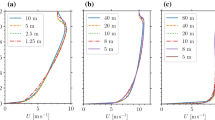Abstract
A method for performing nested grid calculations with a large-eddy simulation code is described. A common numerical method is used for all meshes, and the grid architecture consists of a single outer or coarse grid, and nested or fine grids, which overlap in some common region. Inter-grid communication matches the velocity, pressure and potential temperature fields in the overlap region. Resolved and sub-grid scale (SGS) turbulent fluxes and kinetic energy on the fine grid are averaged to the coarse grid using a conservation rule equivalent to Germano's identity used to develop dynamic SGS models.
Simulations of a slightly convective, strong shear planetary boundary layer were carried out with varying surface-layer resolutions. Grid refinements in the (x, y, z) directions of up to (5, 5, 2) times were employed. Two-way interaction solutions on the coarse and fine meshes are successfully matched in the overlap region on an instantaneous basis, and the turbulent motions on the fine grid blend smoothly into the coarse grid across the grid interface. With surface-layer grid nesting, significant increases in resolved eddy fluxes and variances are found. The energy-scale content of the vertical velocity, and hence vertical turbulent fluxes, appear to be most influenced by increased grid resolution. Vertical velocity spectra show that the dominant scale shifts towards higher wavenumbers (smaller scales) and the magnitude of the peak energy is increased by more than a factor of 3 with finer resolution. Outside of the nested region the average heat and momentum fluxes and spectra are slightly influenced by the fine resolution in the surface layer. From these results we conclude that fine resolution is required to resolve the details of the turbulent motions in the surface layer. At the same time, however, increased resolution in the surface layer does not appreciably alter the ensemble statistics of the resolved and SGS motions outside of the nested region.
Similar content being viewed by others
References
Andrén, A., Brown, A. R., Graf, J., Mason, P. J., Moeng, C.-H., Nieuwstadt, F. T. M., and Schumann, U.: 1994, ‘Large-Eddy Simulation of a Neutrally Stratified Boundary Layer: A Comparison of Four Computer Codes’, Quart. J. R. Meteorol. Soc. 120, 1457–1484.
Clark, T. L. and Farley, R. D.: 1984, ‘Severe Downslope Windstorm Calculations in Two and Three Spatial Dimensions Using Anelastic Interactive Grid Nesting: A Possible Mechanism for Gustiness’, J. Atmos. Sci. 41, 329–350.
Clark, T. L. and Hall, W. D.: 1991, ‘Multi-Domain Simulations of the Time Dependent Navier-Stokes Equations: Benchmark Error Analysis of Some Nesting Procedures’, J. Comp. Phys. 92, 456–481.
Danabasoglu, G., Biringen, S., and Street, C. L.: 1994, ‘Application of the Spectral Multidomain Main Method to the Navier-Stokes Equations’, J. Comp. Phys. 113, 155–164.
Deardorff, J. W.: 1980, ‘Stratocumulus-Capped Mixed Layers Derived from a Three-Dimensional Model’, Boundary-Layer Meteorol. 18, 495–527.
Germano, M., Piomelli, U., Moin, P., and Cabot, W. H.: 1991, ‘A Dynamic Subgrid-Scale Eddy Viscosity Model’, Phys. Fluids A. 3, 1760–1765.
Gerz, T., Howell, J., and Mahrt, L.: 1994, ‘Vortex Structures and Microfronts’, Phys. Fluids 3, 1242–1251.
Grell, G. A., Dudhia, J., and Stauffer, D. R.: 1994, ‘A Description of the Fifth-Generation Penn State/NCAR Mesoscale Model (MM5)’, NCAR technical note, NCAR/TN-398 + STR.
Henderson, R. and Karniadakis, G. E.: 1991, ‘Hybrid Spectral-Element-Low-Order Methods for Incompressible Flows’, J. Sci. Comp. 6, 79–100.
Klemp, J. and Duran, D.: 1983, ‘An Upper Boundary Condition Permitting Internal Gravity Wave Radiation in Numerical Mesoscale Models’, Mon. Wea. Rev. 11, 430–444.
Mahrt, L. and Gibson, W.: 1992, ‘Flux Decomposition into Coherent Structures’, Boundary-Layer Meteorol. 40, 283.
McWilliams, J. C., Gallacher, P. C., Moeng, C.-H., and Wyngaard, J. C.: 1993, ‘Modeling the Oceanic Planetary Boundary Layer’, Large-Eddy Simulations of Turbulent Flows, Lecture Notes in Engineering, Cambridge University Press, pp. 441–454.
McWilliams, J. C., Sullivan, P. P., and Moeng, C.-H.: 1996, ‘Langmuir Turbulence in the Ocean’, J. Fluid Mech., In Press.
Moeng, C.-H.: 1984, ‘A Large-Eddy-Simulation Model for the Study of Planetary Boundary-Layer Turbulence’, J. Atmos. Sci. 41, 2052–2062.
Moeng, C.-H., and Wyngaard, J. C.: 1988, ‘Spectral Analysis of Large-Eddy Simulations of the Convective Boundary Layer’, J. Atmos. Sci. 45, 3575–3587.
Moeng, C.-H., and Sullivan, P. P.: 1994, ‘A Comparison of Shear Buoyancy Driven Planetary-Boundary Flows’, J. Atmos. Sci. 51, 999–1022.
Nieuwstadt, F. T. M., Mason, P. J., Moeng, C.-H.: and Schumann, U.: 1991, ‘Large-Eddy Simulation of the Convective Boundary Layer: A Comparison of Four Computer Codes’, 8th Symposium on Turbulent Shear Flows, Springer-Verlag.
Peltier, L. J., Wyngaard, J. C., Khanna, S., and Brasseur, J.: 1995, ‘Spectra in the Surface Layer’, J. Atmos. Sci., In Press.
Perng, C. Y. and Street, R. L.: 1991, ‘A Coupled Multigrid-Domain Splitting Technique for Simulating Incompressible Flows in Geometrically Complex Domains’, Inter. J. Numer. Methods in Fluids 13, 269–286.
Phillips, N. A. and Shukla, J.: 1973, ‘On the Strategy of Combining Coarse and Fine Grid Meshes in Numerical Weather Prediction’, J. Appl. Meteorol. 12, 763–770.
Reynolds, W. C.: 1989, ‘The Potential and Limitations of Direct and Large Eddy Simulations’, Whither Turbulence ? or Turbulence at the Crossroads, Cornell University.
Skamarock, W. C. and Klemp, J. B.: 1993, ‘Adaptive Grid Refinement for Two-Dimensional and Three-Dimensional Nonhydrostatic Atmospheric Flow’, Mon. Wea. Rev. 121, 768–804.
Spalart, P. R., Moser, R. D., and Rogers, M. M.: 1991, ‘Spectral Methods for the Navier-Stokes Equations with One Infinite and Two Periodic Directions’, J. Comp. Phys. 96, 297.
Sullivan, P. P., McWilliams, J. C., and Moeng, C.-H.: 1994, ‘A Subgrid-Scale Model for Large-Eddy Simulation of Planetary Boundary-Layer Flows’, Boundary-Layer Meteorol. 71, 247–276.
Walko, R. L., Tremback, C. J., Pielke, R. A., and Cotton, W. R.: 1995, ‘An Interactive Nesting Algorithm for Stretched Grids and Variable Nesting Ratios’, J. Appl. Meteorol. 34, 994–999.
Wyngaard, J. C., 1984, ‘Large-Eddy Simulation: Guidelines for its Application to Planetary Boundary Layer Research’, US Army Research Office Contract No. 0804.
Author information
Authors and Affiliations
Rights and permissions
About this article
Cite this article
Sullivan, P.P., McWilliams, J.C. & Moeng, CH. A grid nesting method for large-eddy simulation of planetary boundary-layer flows. Boundary-Layer Meteorol 80, 167–202 (1996). https://doi.org/10.1007/BF00119016
Accepted:
Issue Date:
DOI: https://doi.org/10.1007/BF00119016




